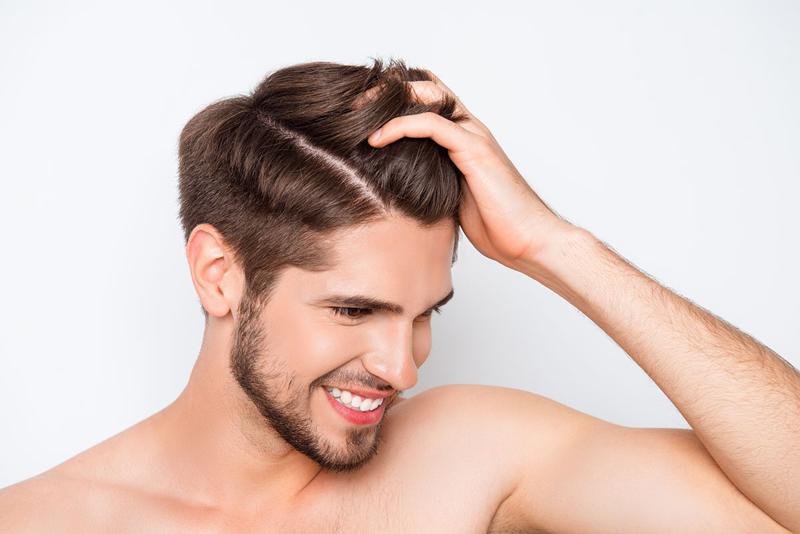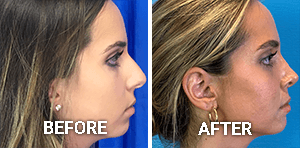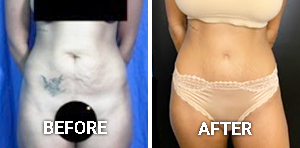FUE Hair Transplants
Conveniently located to serve the areas of Beverly Hills and Greater Los Angeles

Follicular unit extraction (FUE) is a method of hair transplantation that helps to restore a patient’s natural hair appearance following hair loss. While there are many hair restoration methods, FUE is one of the most effective. Instead of using medications to promote growth or slow balding or grafting large strips of skin and hair, FUE removes individual hair follicles from elsewhere on the body and places them into the skin to create thicker, fuller hair with a natural appearance.
Dr. Michael Omidi knows how important hair is to one’s confidence. As a double-board certified plastic surgeon, he has achieved successful results with short recovery times in thousands of procedures, and we can assure you that your results will be effective. If you want to regain your confidence and live life with a full, beautiful, thick head of hair, then do not hesitate to begin planning your treatment.
Take the first step by scheduling a consultation with Dr. Omidi. If you have any questions about the procedure, our practice, our doctors, or anything else, please call our Beverly Hills office at (310) 281-0155 and speak with one of our specialists.
If you are interested in other procedures at Dr. Omidi’s practice, visit his blog.
Contents
About FUE
Hair loss is a common issue that many individuals will face as they age. Androgenic alopecia is more common for males than females; typically affecting 67% of all male patients and 24% of female patients. (1) Hair is also one of the most defining features of an individual’s identity. It is also one of the most diverse forms of personal expression. As such, hair loss can reduce one’s self-esteem and feelings of identity. Fortunately, significant advancements have been made in the field of hair restoration and transplantation.
One of the most successful methods offered is FUE. This technique is a variation of singular unit extraction. Singular unit extraction is somewhat of a misnomer because each extracted unit can contain up to four individual hair follicles. While much more time-consuming, FUE removes each hair follicle one by one. This ensures that you are left with thick, natural-looking hair and a healthy scalp. Other methods do not offer optimal results. Hair growth compounds like minoxidil, finasteride, ketoconazole, and others may leave you with suboptimal results and a longer treatment period. (1)
Benefits
FUE offers similar benefits to other hair transplantation procedures with extra efficiency and satisfaction. By placing each follicle into the scalp individually, the skin can better accept and integrate the new hair than with other methods. This produces a much healthier and fuller head of hair. With this rejuvenated hair, patients can see their confidence and self-esteem increase drastically. Additionally, these patients (especially male patients) may be the subject of cruel jokes due to their hair loss. Transplanting hair can eliminate this. A full head of hair will also mean a younger, more vibrant, and rejuvenated appearance, helping you look much more youthful.
If you want to revitalize your scalp and have hair that makes you happy and proud again, then we encourage you to schedule a consultation with Dr. Omidi. The sooner you do, the sooner you can begin your treatment.
Candidates
Any individual experiencing hair loss may be eligible for an FUE hair transplant. However, patients must meet certain requirements for FUE to be an effective treatment. Dr. Omidi may perform a FOX (shortened “follicular extraction”) test to determine how tightly your skin holds onto its existing follicles and estimate how tightly the newly placed follicles will be held. (2) Additionally, patients will need to have enough hair in the donor area to transplant safely and minimize complications.
Hair textures can vary, but this is not a concern in these procedures. Patients of any hair texture can undergo an FUE hair transplant without complications.
Personal Consultation
When you meet with Dr. Omidi to plan your FUE treatment, you will first discuss your motivations behind pursuing a hair transplant. It may be helpful to bring photos of your previous hairstyles to help show Dr. Omidi what your goals are. Once you have discussed your goals, Dr. Omidi will examine your head and scalp. Either he or a member of his team will take photographs of your scalp to reference during planning. Once we have obtained the necessary information, you will receive preparation instructions and schedule your procedure.
Preparation
Minimal preparation is required for an FUE hair transplant. Instead of general anesthesia, you will receive a strong local anesthetic during the procedure. This means that you will not be required to fast or alter your medication regimen. We do, however, recommend that you avoid alcohol and blood-thinning medications like aspirin and ibuprofen to minimize bleeding. While bleeding is already minimal, anything that can thin the blood can increase this.
We also recommend that you arrange transportation to and from your procedure. It is generally safer to avoid driving after your procedure. Finally, you must wash your scalp very well on the morning of your procedure. Any present dirt or debris can lead to complications.
Procedure
We administer a strong local anesthetic in lieu of general anesthesia. You will sit in a comfortable position to allow the operating team sufficient access and visibility to your scalp. Dr. Omidi will select hair follicles one by one, and use a micropunch instrument to carefully remove them. He pushes the punch into the skin and twists it to maneuver the hair follicle loose and dislodge it from the skin. Once loosened, he uses forceps to separate the hair from the skin. (2) Because FUE transplants achieve their results by transplanting each hair follicle individually, these procedures are generally longer. However, this also ensures meticulous attention to detail and longer-lasting results.
Recovery

Dr. Omidi’s patients normally experience a swift recovery following an FUE hair transplant. The scalp and head receive ample blood flow, so your head will naturally receive the nutrients it needs to heal quickly. Your scalp may be numb and swollen for a few days, but this will dissipate in around a week. It is important to keep your head clean during your healing to prevent infection. If Dr. Omidi prescribes antibiotics and pain medications, please take these as instructed.
We encourage you to gently wash your scalp at least twice each day until you start to see your condition improve. While hair transplanting is a minimally invasive procedure, most patients will still take a few days off from work to recover. Finally, we encourage patients to avoid any activities that could result in lots of sudden head movements.
Results
As your healing progresses, the newly placed hair follicles will settle. Once they have healed, your hair will grow naturally. Over time, you will see improved hair growth. This will look similar to the appearance of your hair before your hair loss. As your hair continues to grow, your confidence and happiness will grow as well.
Corresponding & Complementary Procedures
FUE hair transplants are not limited to the scalp, nor are they limited to patients with androgenic alopecia. Dr. Omidi has achieved success in restoring eyebrows and other facial hair with this procedure. Patients who have lost hair on their scalp or in these areas as a result of injuries, burns, diseases, and more have been able to successfully regrow hair after receiving transplants. If you want to receive a hair transplant in areas other than your scalp, please discuss this with Dr. Omidi at your consultation.
Cost of a Hair Transplant in Beverly Hills
Each hair transplant procedure is different, and therefore, costs will vary. The total cost of your hair transplant will depend on your individual treatment plan. When you meet with Dr. Omidi for your consultation and discuss your goals, you will receive a quote for your procedure.
If you have any other questions, please call our Beverly Hills office at (310) 281-0155 to get the information you need.
FAQ
Where does the transplanted hair come from?
The hair that will be placed into your scalp during your FUE hair transplant will typically come from the back of your head below your occipital lobe. This hair is normally more resistant to androgenic alopecia. Additionally, because of the shape of the head and occipital lobe, any scarring from hair harvesting will be hidden by hair growth at this site.
Will my race affect my hair transplant?
No. Although hair textures, colors, and more vary widely across races, ethnicities, and genetics, FUE procedures can be performed on any patient, regardless of their hair type.
Will dandruff affect my hair transplant?
No. Dandruff will not affect your hair transplant. You will wash your scalp very well before your procedure and Dr. Omidi’s team will wipe away any extra dirt, debris, and oils before applying your anesthetic.
Will FUE prevent hair loss?
No. FUE is a way to reverse the effects of hair loss. Hair will only grow in the sites that it is transplanted to. It will not prevent hair loss, but you will have more hair on your head and see long-lasting results.
Is FUE only available for my scalp?
No. FUE can treat eyebrows, facial hair, and more.
References
- Zito PM, Raggio BS. Hair Transplantation. PubMed. Published 2021. https://www.ncbi.nlm.nih.gov/books/NBK547740/
- Dua A, Dua K. Follicular unit extraction hair transplant. Journal of cutaneous and aesthetic surgery. 2010;3(2):76-81. doi:https://doi.org/10.4103/0974-2077.69015





